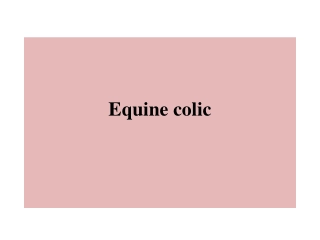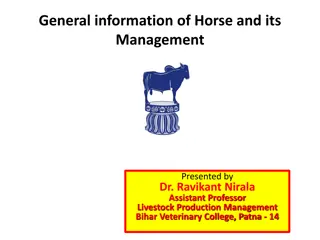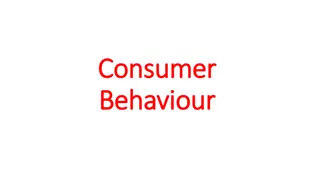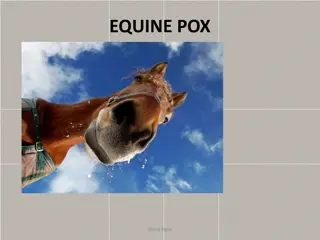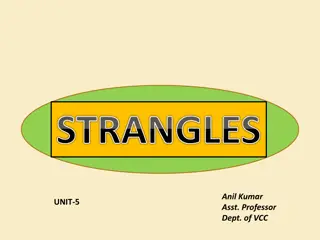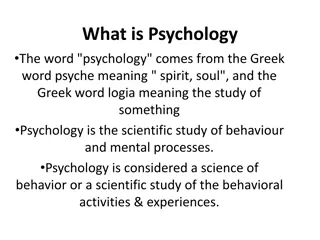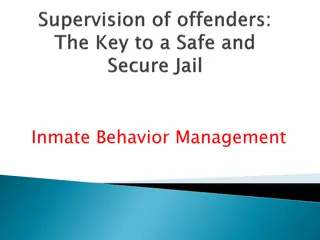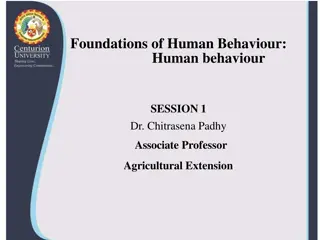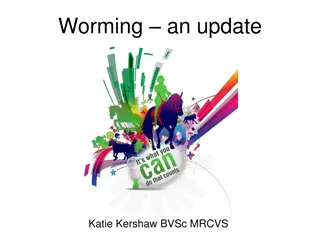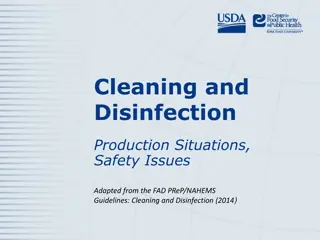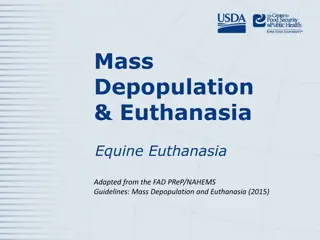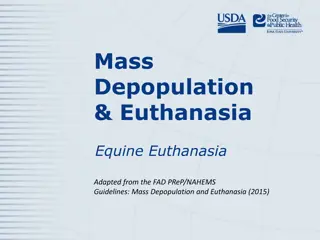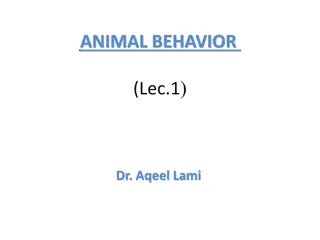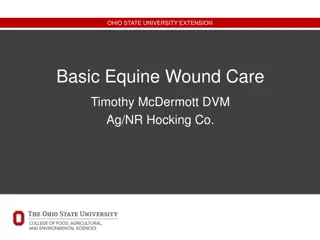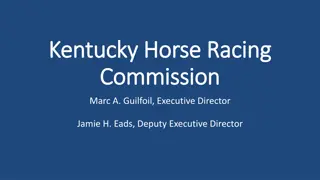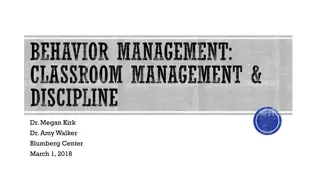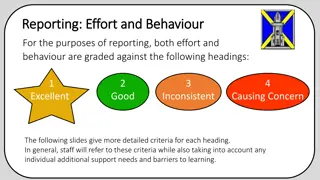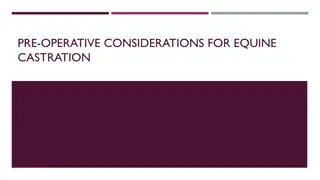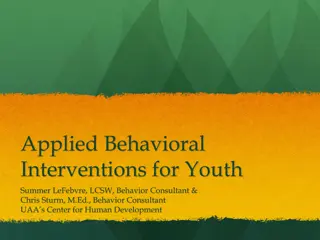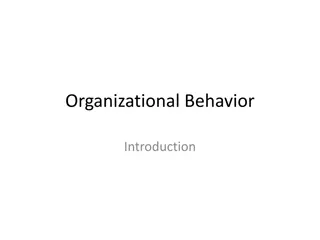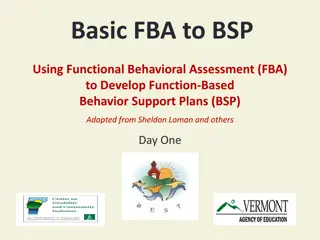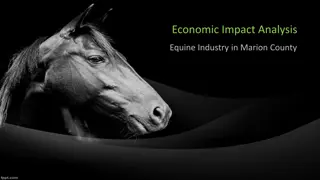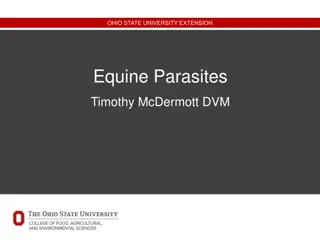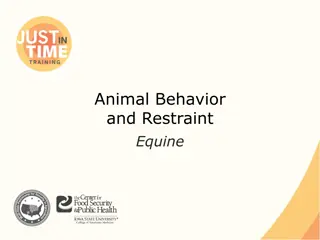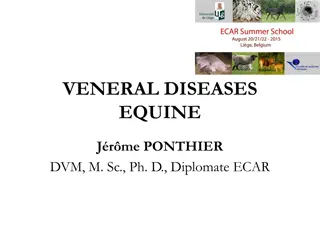Equine colic
Learn about the definition, causes, and types of colic in horses. Discover how to treat and prevent this potentially deadly condition.
0 views • 18 slides
Horse boarding business plan example
Consider a horse boarding business plan as your blueprint for building a sanctuary where horse owners entrust their beloved companions. It's a strategic playbook, detailing services, pricing, target markets, marketing strategies, and financial projections to ensure a thriving venture in the equine w
0 views • 37 slides
Function Based Thinking
Function-based thinking in Missouri Schoolwide Positive Behavior Support, emphasizing data-based decision-making, mission clarity, and effective teaching practices. Understand how behavior is related to the environment and how environmental interventions play a key role in shaping expected behaviors
6 views • 27 slides
Addressing Predatory Behavior in the Fellowship
Predatory behavior, especially towards vulnerable members, is a concerning issue in the fellowship. This behavior includes unwelcome advances, exploitation of power dynamics, and institutional sexism. The discussion on predatory behavior necessitates honest dialogue and a united approach for a safer
3 views • 13 slides
Understanding Poll Evil and Yoke Gall in Horses: Symptoms and Treatment
Poll evil and yoke gall are common afflictions affecting horses, particularly in the neck region. Poll evil is an inflammatory condition characterized by a painful swelling at the top of the neck, while yoke gall is localized acute inflammation caused by yoke pressure. Poll evil is typically treated
0 views • 8 slides
Horse Management and Common Terminology Overview
Dr. Ravikant Nirala, Assistant Professor at Bihar Veterinary College, presents comprehensive information on horse management and common terminology associated with equine production. The content covers the position of horses in the animal kingdom, terminology for different horse genders and ages, mi
1 views • 15 slides
Understanding Consumer Behavior in Marketing
The design of a marketing program starts with understanding consumer behavior. Consumers, as the end users, play a crucial role in shaping market trends. Producers seek insights into consumer personas, market behaviors, and influencing factors. Management focuses on the consequences of consumer beha
2 views • 26 slides
Equine Coital Exanthema: Overview, Symptoms, and Management
Equine coital exanthema, caused by Equine Herpesvirus 3, is a contagious venereal disease affecting horses globally. It primarily manifests as genital lesions in stallions and mares, transmitted sexually or through contact with contaminated materials. While it is typically self-limiting, it can be p
0 views • 23 slides
Understanding Strangles in Horses: Symptoms, Treatment, and Complications
Strangles, also known as Equine Distemper, is an infectious disease affecting horses and equids. It is characterized by upper respiratory tract infection, lymph node abscesses, and various complications. Symptoms include nasal discharge, coughing, and swelling of lymph nodes. Prompt diagnosis and tr
3 views • 11 slides
Understanding Psychology: The Science of Behavior and Mental Processes
Psychology is the scientific study of behavior and mental processes. Psychologists study both observable behavior and private mental processes. The primary goals of psychology are to describe, understand, predict, and control behavior. Different branches of psychology, such as applied psychology, cl
2 views • 29 slides
Understanding Inmate Behavior Management in Correctional Settings
Inmate Behavior Management in correctional facilities involves supervising inmates, implementing corrective discipline, and fostering a fair and consistent environment. It emphasizes the importance of behavior management plans, identifying undesirable traits in supervision, and passing educational a
0 views • 19 slides
Understanding Human Behavior: Foundations and Factors
Human behavior is a multifaceted subject influenced by genetic makeup, culture, and individual values. It encompasses both overt actions and covert thoughts, a product of the individual and environmental factors. Psychologists study behavior from visible (overt) actions like playing football to inne
0 views • 20 slides
Understanding Normal and Abnormal Behavior: Perspectives and Definitions
Normal behavior varies from person to person and society, influenced by individual preferences and societal norms. Abnormal behavior is characterized by an inability to function effectively or personal discomfort. The concept of normality and abnormality in psychology raises complex questions about
2 views • 8 slides
Veterinary Update on Equine Worming Protocols
Explore the latest insights on equine worming practices, including details on common types of worms, clinical signs, prevention, treatment, and diagnostic methods. Learn about dealing with threadworms, tapeworms, pinworms, bots, and lungworms in horses and donkeys.
0 views • 36 slides
Exploring 4-H Equine Cloverbud Opportunities
Delve into the world of 4-H Equine Cloverbuds where young horse enthusiasts can participate in a variety of activities such as Horse Bowl, County Shows, Western Games, and more. Cloverbuds can engage in the Horseless Horse project to learn about equine care, breeds, grooming, and tack. They can also
0 views • 9 slides
Guidelines for Cleaning and Disinfection in Animal Production Facilities
Explore key guidelines for cleaning and disinfecting various animal production facilities, including poultry, dairy, swine, equine, and aquaculture. Specific challenges and safety considerations for each type of facility are discussed, highlighting the importance of using appropriate products and te
0 views • 18 slides
Equine Euthanasia Guidelines: Best Practices and Considerations
Equine euthanasia and mass depopulation guidelines emphasize humane treatment, efficient methods, and minimizing emotional impact during animal health emergencies. Techniques such as sedation, acceptable injection methods, and handling protocols are outlined to ensure a stress-free transition for eq
3 views • 14 slides
Guidelines for Equine Euthanasia and Mass Depopulation
Guidelines for equine euthanasia and mass depopulation outline transitioning animals painlessly and stress-free during emergencies. The focus is on humane treatment, minimizing stress, and selecting acceptable methods to safeguard the food chain and prevent disease spread. Handling, sedation, and eu
0 views • 14 slides
Understanding Human Behavior: Insights for Social Workers
This material delves into the intricacies of human behavior, exploring factors influencing behavior such as heredity, environment, intelligence, needs, and motives. It covers the concept of human behavior, stages in life from conception to old age, and theories of human development by eminent psycho
2 views • 71 slides
Understanding Animal Behavior and Ecology
Animal behavior encompasses a range of activities such as feeding, breeding, and social interactions. Ethology focuses on studying behavior in natural environments, while behavioral ecology examines ecological aspects like predator-prey interactions. Sociobiology delves into the evolution of social
3 views • 5 slides
Basic Equine Wound Care: Understanding and Treatment
Learn about basic equine wound care, including initial steps to take, stages of the healing process, types of wounds, and treatment options. Understand how to assess the severity of wounds and the importance of proper care to prevent complications. This guide provides valuable information for horse
0 views • 11 slides
Kentucky Horse Racing: Supporting Equine Breeding in Kentucky
Kentucky offers various incentive programs to support the breeding of Thoroughbreds and Standardbreds, such as the Kentucky Breeders Incentive Fund and the Kentucky Sire Stakes. These programs provide financial rewards to breeders based on the success of their horses in eligible races. Other equine
2 views • 7 slides
Understanding Behavior Management in Classroom Settings
Explore the essential topics of behavior management, classroom strategies, and discipline in educational settings. Delve into the functions of behavior, impact of trauma on learning, and effective management techniques. Learn how to identify underlying reasons for student behaviors, discuss behavior
0 views • 76 slides
Equine First Aid Essentials: Ohio State University Extension Guide
Ohio State University Extension provides a comprehensive guide on equine first aid, covering topics such as injury prevention, vital signs, emergency procedures, common problems like colic and wounds, and colic prevention measures. The guide emphasizes the importance of knowing your horse, contactin
0 views • 17 slides
Targeting Emotions to Facilitate Behavior Change in Older Adults
Efforts in changing health behavior have traditionally focused on social and cognitive factors, but recent evidence highlights the importance of affective states in decision-making and behavior change. Janey Peterson discusses the role of emotions in achieving and sustaining behavior change to benef
0 views • 11 slides
Understanding Electrolytes and Their Importance for Trail Equine Athletes
Explore the crucial role of electrolytes for competitive trail equine athletes, including their functions, absorption in the body, sources of loss, and homemade electrolyte formulations. Learn how electrolytes such as sodium, potassium, and chloride are essential for muscle function, intestinal moti
0 views • 22 slides
Grading Criteria for Effort and Behavior in Educational Reporting
Effort and behavior in educational settings are evaluated based on criteria ranging from Excellent to Causing Concern. Pupils demonstrating excellent behavior show respect, responsibility, and positive engagement in learning. Those with good behavior exhibit cooperation and respect for others, albei
0 views • 9 slides
Anatomy and Blood Supply of the Equine Stomach
The equine stomach is relatively small compared to the horse's body size, with distinct regions such as the cardia, fundus, body, and pyloric region. It is located on the left side of the abdomen, under the ribs. The stomach's blood supply includes branches from the aorta, splenic artery, and hepati
0 views • 23 slides
Pre-Operative Considerations for Equine Castration
Selection of a technique, common agents used to anaesthetize horses, scrubbing procedure, and blocking method are essential pre-operative considerations for equine castration. Closed and half-closed techniques decrease post-operative complications, while various agents can be used for sedation. Prop
0 views • 6 slides
Understanding Equine Influenza: An Overview of Respiratory Tract Infections in Horses
Equine influenza is a contagious upper respiratory infection in horses caused by influenza viruses. This article covers the anatomy of the equine respiratory tract, signs, diagnosis, treatment, prevention, and prognosis of equine influenza. It also discusses the histological structure of the respira
0 views • 18 slides
Understanding Applied Behavior Analysis (ABA) for Youth Interventions
Applied Behavior Analysis (ABA) is a science focusing on improving human behavior by increasing desired behaviors, teaching new skills, and generalizing behaviors. ABA emphasizes observable behaviors, measurement of behavior change, and the use of interventions in various settings like classrooms an
0 views • 25 slides
PBIS Expectations and Behavior Flowchart
The PBIS flowchart outlines behavior expectations and interventions for minor and major incidents in a school setting. It covers disrespectful behavior, disruption, defiance, property damage, theft, possession of weapons, and more. The flowchart guides teachers and staff on managing and addressing s
0 views • 6 slides
Managing Acting-Out Behavior: A Staff Development Program Review
This review discusses a staff development program created by Geoffrey Colvin, Ph.D., from the University of Oregon, focusing on preventing and managing acting-out behavior in students with emotional disturbance or behavior disorders. The program includes video presentations, strategies for behavior
0 views • 22 slides
University of Kentucky Equine Programs Overview
The University of Kentucky's equine programs, led by Dr. Nancy Cox and Dr. James MacLeod, are nationally and internationally recognized for their contributions to equine research and education. With a focus on workforce development, the programs offer undergraduate and graduate opportunities in equi
0 views • 9 slides
Understanding Organizational Behavior and Individual Behavior
Organizational Behavior (OB) is a multidisciplinary field that combines knowledge from various disciplines to study and manage organizations effectively. It emphasizes the application of this knowledge to enhance organizational effectiveness and the well-being of participants. OB is a useful concept
0 views • 38 slides
Function-Based Behavior Support Plans: A Comprehensive Guide
Explore the process of developing Function-Based Behavior Support Plans (BSP) using Functional Behavioral Assessment (FBA). Understand the concepts of function and functional behavior assessment, learn how FBA/BSP fits within a multi-tiered support system, and practice developing BSP for students. D
0 views • 74 slides
Economic Impact Analysis of Equine Industry in Marion County
This economic impact analysis focuses on the Equine Industry in Marion County, particularly the Ocala Metropolitan Statistical Area. The study utilized IMPLAN models to determine the annual economic impact, analyzing data from various sources such as surveys with participants and businesses. The rep
0 views • 16 slides
Understanding Equine Parasites: A Comprehensive Guide by Ohio State University Extension
Explore the intricate world of equine parasites with a detailed guide provided by Ohio State University Extension. Learn about internal and external parasites, common signs of infestation, fecal testing techniques, and specific types like strongyles and roundworms. Discover the importance of proper
0 views • 24 slides
Equine Behavior and Restraint: Understanding and Handling Horses
Discover key insights into equine behavior and restraint techniques for safe handling of horses. Explore topics such as normal behavior, body language cues, flight zones, herding and moving horses, capture and containment methods, and post-handling considerations. Enhance your understanding of equin
0 views • 13 slides
Equine Venereal Diseases: Diagnosis and Treatment Overview by Jrme PONTHIER DVM
Learn about the diagnosis and treatment of equine venereal diseases such as Taylorella equigenitalis in horses. Understand the pathogenesis, transmission, and legal obligations for these diseases in the UE (European Union). Discover the general approaches for diagnosis and treatment in stallions and
0 views • 17 slides
